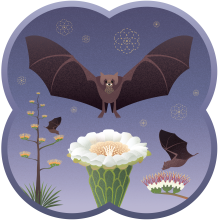Project Overview:

The lesser-long nosed bat (Leptonycteris yerbabuenae) travels north from Mexico to Arizona each summer on a journey that can cover almost 1,000 miles. On this journey, the bats rely on nectar and pollen from agave and columnar cacti. These are also critical food sources for the bats when they arrive at their maternity roosts in Southern Arizona.
The endangered Mexican long-nosed bat (Leptonycteris nivalis) follows a similar long-distance migration from central Mexico to their maternity roosts in Texas and New Mexico, relying on agaves as their sole nectar source in these northern areas.
The US Fish & Wildlife Service, in partnership with the USA National Phenology Network, is seeking to better understand where and when nectar sources are available for these bats while they are in the northern portion of their range raising their young. This campaign also supports the efforts of Bat Conservation International to collect data on flowering phenology of Agave havardiana and Agave parryi neomexicana in West Texas, which will guide agave restoration efforts in the area.
You can help us document flowering of agave and columnar cacti during the spring and summer flowering periods. This information will be used by the USFWS to conserve and promote habitat for lesser long-nosed bats.
See what we learned from this campaign in 2024.
Read 2024 results from Sands Ranch, a Pima County data collection site.
SIGN UP FOR Flowers for Bats MESSAGES!
You will receive messages full of findings, observation tips, and campaign-specific opportunities. Don't miss out!
How to Participate
1. Join Nature's Notebook. If you haven't already, create a Nature's Notebook account. If you need more details on getting started, take the Observer Certification Course at learning.usanpn.org. You can set up a phenology monitoring site in your backyard or another location that you frequent.
2. Select one or more of the following species to track:
- saguaro (Carnegiea gigantea)
- organ pipe cactus (Stenocereus thurberi)
- cardon (Pachycereus pringlei)
- Palmer's century plant (Agave palmeri)
- Parry's agave (Agave parryi)
- desert agave (Agave deserti)
- Havard's century plant (Agave havardiana)
- American century plant (Agave americana)
Interested in tracking agave? You can sign up to adopt one of our Agave trails to track flowering this summer! Check out the map here and then email Samantha@usanpn.org if you'd like to sign up for a Trail.
3. Take observations. We invite you to track flowering of saguaro and agave plants ideally 2-3 times per week during the flowering season. Remember, it's important to capture when your plants are not flowering as well as when they are flowering. Capturing that last "no" report prior to the first "yes" for flowers or flower buds and open flowers helps pinpoint when flowering first begins!
4. Report your observations. As you collect data during the season, log into your Nature's Notebook account and enter the observation data you record. You can also use our mobile app to submit your observations!
Download a flyer about Flowers for Bats
Download the full Flowers for Bats Monitoring Protocol, or the One-page Monitoring Guide
EARN YOUR Flowers for Bats BADGE
See it on your Observation Deck.

Agave Identification:
Agaves can be tricky to identify. Pay attention to the length and width of the leaves, the color of the leaves, and the overall size of the plant. If you see an agave blooming, you can consider it to be full size.
|
Agave palmeri leaf color ranges from pale green to dusty-colored light green, gray-green, or bluish green. Its leaf margins are straight, with small teeth regularly spaced along the margin with even smaller teeth often in between. It is a medium-sized to large-sized agave (3-4 feet tall) with leaves 3-4 inches wide and 14-29 inches long. Agave parryi leaves are gray-ish to light green or light blue-green in color. It has a compact, dense rosette. Its leaf margins are straight or can have a slight undulation. Its leaves are mostly flat with a barely concave top surface. It is a medium-sized agave (12-20 inches tall) with broad-ish leaves 3-5 inches wide and 10-16 inches long. Agave deserti leaves are dusty-colored gray or gray-blue to green. Its leaf margins are straight in most forms of this species, with small regularly spaced teeth. It freqnetly has banding on its leaves. It is a medium-sized agave (12-19 inches tall) with leaves 2-3 inches wide and 6-16 inches long. Agave havardiana has a glaucous-grey to grey-green color. Its succulent leaves are arranged in a rosette and are 2-4 ft. in height. The leaves are typically 15-28 in. long and 6-11 in. wide. The leaves will have teeth on their edges. Phenophase Photo Guide (coming soon) » Agave americana, is often gray to gray-blue but can be dark green or varigated. This species has significant amounts of horizontal striping on the backs of the leaves. It is a very large agave (6-10 feet tall) with very wide leaves 6-10 inches wide and 3-6.5 feet long. This species is commonly planted as an ornamental in yards around Tucson. |